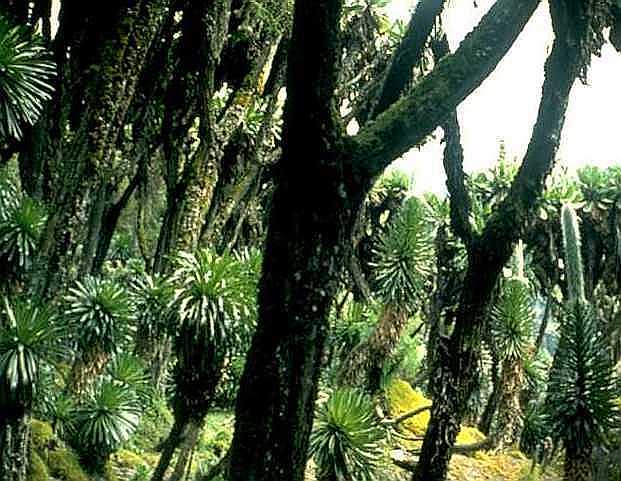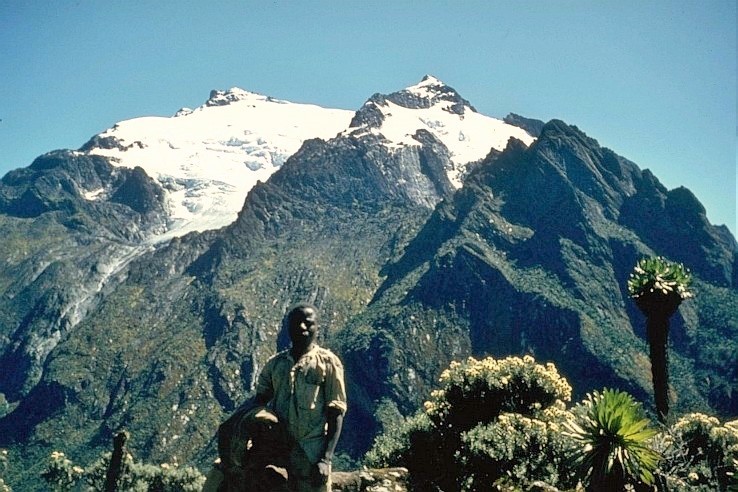The Ruwenzori Mountains - or the Mountains of the Moon - rise to very high altitudes along the border area between the western Uganda and Zaire in central Africa. Apart from being one of the main sources of the Nile, they are among the strangest and most mysterious mountains in the world.
The lower parts of Ruwenzori are covered with dense tropical rain forest separated by powerful rivers. Everywhere, there is an immense fertility due to the very heavy rainfall all year round (as an average, it rains 300 days during the year). Trekking here is a tough walk for hours by hard accessible trails blocked by fallen trees, crossing muddy swamps. The forest is very different in appearance and species. Some of the remarkable vegetation in the lower regions consist of plenty of 2-3 meter high fern trees and extensive areas covered by thousands of 10 meter high bamboo trunks swinging over your head. Sometimes the trail disappears, and the direction leads you through big, muddy swamps. It's quite a good comparison to imagine, that you have just left your time machine after a long time travel back to a remote geologic age. Most of the vegetation feels unfamiliar and over-sized, and the whole landscape makes you think of the earth in a prehistoric time.
 ==>
==>
From the forest at Lake Kitandara.
At this place, at an altitude of 4.000 meters in central Africa, you felt completely
isolated from the rest of the world because everything seemed strange and unknown. Entering
the dense vegetation at dusk time was really sinister, and beyound any doubt, this place would
be ideal for another movie about the dinosaurs!
When you reach the higher altitudes of Ruwenzori, the vegetation is less dense , but the landscape definitely doesn't get more familiar for that reason! Gradually, the rain forest is replaced by forests made of giant, crippled heather trees covered by lichens and mosses. Close to the snow line, you find forests and swamps with giant senecio and giant lobelia trees. Especially these plants make you feel VERY small because their leaves and flowers are over-sized compared to what you are used to see. Imagine, that YOU shrunk to a height of 10 centimeters and were put into a grass field with all its wild flowers. THAT comparison is not very bad at all! Entering these forests at dusk time was VERY sinister, and I am sure, that the area would be a perfect scene for another movie about dinosaurs. This idea is hereby passed on to Steven Spielberg, if he would like to make another continuation of "Jurassic Park"!
Finally, on top of everyting, you find eternal snow and glaciers at an altitude of more than 5.000 meters above sea level, which makes you forget, that you are in the heart of tropical Africa.
History and legends
You can find legends about these mountains all the way back to the beginning of the history of mankind. The trade travels of the old egyptians gave birth to rumours about the source of the Nile as a huge, snow-covered mountain in the heart of Africa. However, bacause of the lack of exact information, the Mountains of the Moon remained in the world of legends and dreams.
When Ptolemaeus made his famous world map in the 2.nd century A.C., he put a huge mountain in the middle of Africa and described it as "the Mountain of the Moon, feeding the source lakes of the Nile with its snow". Both the description and the position on the map is astonishingly correct compared to the geographic knowledge at that time, and although Ruwenzori is drawn on newer maps up through history, none of these show their position as correct as the map of Ptolemaeus. As the centuries passed, the Mountains of the Moon were considered to be something unreal - and honestly, who would ever believe anybody in older times, who started talking about snow-covered mountains under the burning sun of equator?
Even a long time after the legendary expeditions to Central Africa started, Ruwenzori remained a mystery. In 1864, Baker forced his way along the Nile to Lake Albert, and in 1876, Stanley reached Lake Edward - But neither of them realized, that between these 2 lakes, there was a 150 km long mountain chain with summits higher than 5.000 meters. The explanation of this failure is, that Ruwenzori as good as always is hidden by mist and clouds. According to the local language of the natives, "Ruwenzori" means "The King of Mists" or "The Rain Maker".
The first time Ruwenzori was seen by humans outside Africa was in 1888 at Lake Albert, at Stanley's second visit, and it happened accidentally. When Stanley after a month's stay left the west bank of Lake Albert, one of the locals made him aware of a strange phenomenon in the horizon. The african called it "A mountain made of salt". The secret "Mountains of the Moon" were hereby discovered by non-african people.

After breakfast, we started the ascent to the Scott Elliot Pass (4.500 meters), and
during the whole trip, we had a magnificent
view of snow and glaciers. The mountain in the background is Mount Speke (5.035 meters). It's strange to imagine, that the
snow on top of these very high mountains is one of the sources of the Nile.
Many years ago, I spent about a week trekking in Ruwenzori with a local african. We started from his village Ibanda, in one of the fertile valleys stretching from the mountains down into Uganda, and during the week, we walked up through this fantastic scenery. It was absolutely necessary to join somebody with local knowledge. As mentioned above, the trail was sometimes hard to find and often vanished into extensive swamps, where you had to jump from one grass hillock to the other for hours.
In the latest edition of Lonely Planet's guide about East Africa I read recently, that some trekkers had written the following
on the wall of the Bujuku mountain hut:
"Jesus learned how to walk on water. After 5 days here, everybody could do it!"
Unfortunately, my guide's only language was swahili, so we were unable to talk much together. I DID bring an english-swahili dictionary, but our only conversation was confined to single words at the camp fire at night. However, there is ONE word in swahili, which I will never forget. That's MATOPE. It means mud!
I think we were very lucky about the weather. During the week, we only had real rain one of the days in spite of the high average rainfall and in spite of the fact, that the rainy season was statistically starting at this time of the year! However, during THAT afternoon, it rained more than I have ever seen. On the way back to the civilization, in the middle of a bamboo forest, it suddenly started pouring down, lighting and thundering in an extreme way, even compared to the tropics. Our trail became a water course, and the big river in the bottom of our valley turned into a foaming inferno - quite scaring to watch since we HAD to cross it more times in order to get down!
No matter whereever you go in the world, I don't think you will find a more odd and awe-inspiring landscape than the Ruwenzori Mountains. The snow and the glaciers together with the tropical rain-forest, the mysterious, sinister mist and the violent thunderstorms, the strange plants in the mud, which make you think of the swamp forests of the jurassic or the carbon age - everything together leaves a strong, unforgettable impression in the mind of the visitor. Many articles and books have been written about Ruwenzori, and all of them reflect the enthusiasm of their writers. These mountains have been unchanged for thousands of years, and they give you a feeling of being totally outside time and space, because everything is different from what you know.